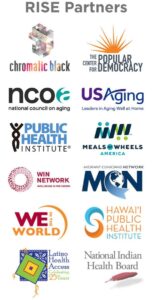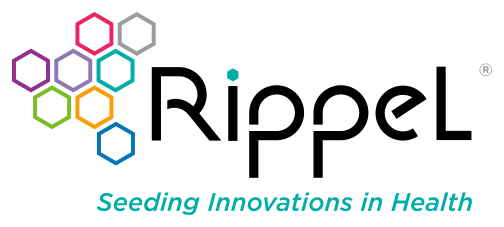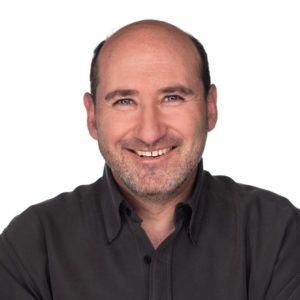Contributing Author: Melanie Otero
Communities RISE Together: Building Belonging and Civic Muscle Through Community Vaccine Mobilization
As co-founder of Well Being In the Nation (WIN) Network, Rippel’s ReThink Health initiative has worked closely for the past few years with the WIN Network’s executive lead, Somava Saha, MD, a visionary leader dedicated to creating the conditions needed for intergenerational well-being and equity in partnership with people, organizations and communities around the world. In response to inequities in the rate of COVID-19 vaccinations in many communities of color compared to white areas, and with the surge in COVID-19 cases due to the more transmissible Delta variant, Saha co-led the Communities RISE (Reach, Immunizations, System Change for Equity) Together (RISE) initiative, an alliance of partners connected to 2400+ organizations across the nation who are deeply rooted in communities and have deep trust with Black, Native-American, Latinx, Asian-American/Pacific-Islander, immigrant/migrant, and low-income older adult populations.
ReThink Health applauds the way RISE partners have orchestrated an equitable COVID-19 response. Their approach has been to consciously expand the circle of belonging among those historically left out, while also strengthening civic muscle across a vast network of people and organizations to achieve success in vaccination and testing. This intentional investment in belonging and civic muscle through ten RISE partners with funding from the US Department of Health and Human Services has led to 44+ million people reached, 215,000 connected to their social and well-being needs, and 184,000+ vaccinated.

When partners first came together to form the RISE initiative to orchestrate a COVID-19 response, they predicted that the places hardest hit by the virus would be the same places hardest hit by historic inequities.
They were right.
At the same time, RISE knew that marginalized communities—whether they were migrant workers or Black faith-based communities—had their own natural infrastructures and a wealth of civic muscle. “They have to navigate incredibly complex systems with a lot of silos where people have to prove they are poor multiple times, to prove they deserve it,” said Saha. “The usual dynamic is set up in a way that communicates they don’t deserve to belong. Somehow, it’s their fault. If we can flip the narrative [to show] that communities experiencing inequities have developed incredible systems of resilience, and if you can trust that as part of the solution we need, what you see is that those communities can lead the way.”
ReThink Health Definitions
Belonging & Civic Muscle: The special capacities of people and institutions that convey to all a sense of being part of a community (belonging) and having power (civic muscle) to influence the policies, practices, and programs that shape the world.
Interdependence: Working together with a common, shared purpose; each organization has clarity about its own distinct, unique role and the roles of others, as well as a holistic understanding of how they interact to create cohesion across organizations.
RISE saw the opportunity to create an equity-first approach by tapping into each community’s civic muscle and combining basic needs with vaccination awareness and clinics. By ensuring a disproportionate amount of resources—funding, food, paycheck protection, back to school backpacks—went to the communities, and the trusted messengers of those communities were the ones mobilizing and bringing the resources, they could introduce vaccinations in a trusted environment.
“If we could help make it easier by prioritizing resources using an equity-first approach, and if communities could be free to lead through non-traditional connections and relationships, we believed we would get far greater results,” said Saha. “And in doing that, we are demonstrating that we can vaccinate thousands of people.”
RISE partners come together weekly to share their experiences and learning. “One thing I learned is that trust creates new possibilities,” said Saha. “The joy of what we’ve been able to do in RISE through funding from HRSA, the CDC, and others, has been to show that trusted messengers and resourceful communities are creating bridges and making connections across boundaries. In the longer term, we’re seeing next level civic muscle emerge as we discover the possibilities when systemic belonging is led by those who experience inequities bringing their natural gifts of resilience and resourcefulness to change systems and chart their path forward.”
Communities RISE Together Partners:
CHROMATIC BLACK
The Center for Popular Democracy
The Hawai’i Public Health Institute
Latino Health Access (LHA)
Migrant Clinicians Network
Meals on Wheels America
National Council on Aging
USAging
Public Health Institute/Center to
Advance Community Health and Equity
WE in the World
Well Being In the Nation Network
RISE partners are expanding belonging and civic capacity by:
Connecting health departments and nontraditional trusted community messengers
Connecting trusted messengers with each other and with civic leaders across boundaries
Working with traditional and nontraditional vaccine and well-being ambassadors
Building communication campaigns to address misinformation and disinformation
Using real-time data to drive an equitable and strategic response and resilience strategy
Migrant Clinicians Network: Trusted Messengers Cultivate Interdependence and Break Through Barriers
Working with RISE, Migrant Clinicians Network (MCN) saw how interdependence amplified and took on new meaning during the pandemic. “The way Soma [Saha of the WIN Network] has attacked the project is phenomenal,” said Moises Arjona Jr., an MCN contractor and program manager. “She is so in tune to everyone’s needs, sensitivity, and understanding culture—not just as one culture, but seeing it as a whole. It was a different format for understanding we are all assets and have skills we can apply to a project. We also spent time understanding the barriers, why they were there, and how we could work with them. When we stepped back, we realized there was a different way of working to accomplish our goal of getting people vaccinated.”
MCN supports health care workers on the frontlines in addressing the social determinants of health among underserved communities like migrants, immigrants, refugees, and food and farmworker communities. They link clinicians to migrant workers, but during the pandemic, one person—the person the workers trusted most—would play an essential role to the interdependence critical to getting workers vaccinated: The lider.
In migrant communities, the most trusted messengers are called lideres, translated to “leaders” in English, but better described by Arjona as “community champions.” The lider is the one person in every migrant community whom everyone goes to for help. He or she is the volunteer voice of the workers, a recognized leader from within the community who understands their language, culture, and issues and the importance of advocating on their behalf. Lideres are entrusted to liaison with farmers, local law enforcement, and hospitals. They fight for better conditions for the workers and guide them from one location to the next. They are resilient, with strong civic muscle, working to create belonging among migrant workers and families. When MCN’s work pivoted to COVID-19 vaccination awareness and access, the lideres were instrumental.
Arjona and his colleagues quickly realized myths and mistrust of government had created barriers to vaccines. Latinx people also have had experiences being mistreated by the medical community, similar to the legacy of Tuskegee. In some communities, there was hostility toward anyone promoting vaccines.
“We had to get to the people who knew what was going on in the communities” said Arjona. “What were the issues we didn’t know about? We contacted some people ourselves, but they didn’t know who we were. Once we went through the lideres, there was trust.”
The funding MCN received through RISE was in turn provided to the lideres and their community partners, who are typically not compensated, demonstrating that their work was valued.
“The lideres were key for MCN to hyper-focus on the assets that were already available in the community and their ability to reach people that traditional systems like the public health department can’t,” said Arjona. “Making contact and providing them and their partners with the money to do the work has been one of the biggest things. It’s building trust with those partners and allowing us to reach more people.”
The partners reached by the lideres know the needs of the community and often work at food pantries, clothing drives, and back to school drives—places trusted by the migrant workers. They were the assets and the pathways to support the task at hand, agreeing to open their events and locations to clinicians and local public health departments to offer vaccines. “Getting everyone on board to do the job was not easy,” said Arjona. “We needed everyone working together toward the same goal, and that is what our partners are doing. Now we are able to share successes and barriers with others.”
One of the successes was the extension of belonging that Arjona witnessed: African American communities and Latinx communities reaching out to each other when they held vaccination events. “They understand that each one of them plays a part in our community and that everyone has a skill set,” he said. “And they see that it’s in all of our best interests to be vaccinated and continue to grow together.”
Chromatic Black: Community Narrative as “the Golden Thread”
Abeni Bloodworth, co-founder and narrative strategist of CHROMATIC BLACK (CB), is fostering belonging through one of the most powerful tools since the beginning of time: story. CB is powered by a community of 10,000 Black artists/activists, technologists, community organizers, and journalists working to build cultural power through the reclamation of story as a public common. Through CB’s partnership with RISE, Bloodworth and her colleagues are galvanizing their artists in 60 mostly rural communities throughout the South, and in San Bernardino, CA, and St. Louis, MO, to capture and tell “COVID LOVE” and “COVID TRUTH” stories.
“The cool thing about working with artists is that they are in the habit of spending time in the space of imagination, creativity, and what is possible,” Bloodworth said. “We knew if we engaged artists in this civic exercise, we would be able to pattern-disrupt and inject the ‘why’ into the framework of addressing health inequity.”
Bloodworth’s experience with RISE resulted from her work with Somava Saha as a fellow of We in the World Network where the conversations centered on racial justice and healing. One of those conversations led to exploring root causes of vaccination hesitancy. She saw the opportunity to connect CHROMATIC BLACK artists with others on the ground to understand the conversations the community was having.
“The listening—that’s the belonging,” Bloodworth said. “How do we invite people in and solution together? Then we’re a community.”
CHROMATIC BLACK deployed local storyteller artists whom Bloodworth describes as being able to “hear between the spaces.” She saw how they could use their own mediums to address their concerns and be in conversation with community through misinformation/disinformation campaigns. Conversations and resulting efforts to overcome vaccine hesitancy came from three pillars of the communities: love, faith, and trust.
The “Golden Thread”
After listening to stories of the people in Atlanta, GA, artists pivoted from the public narrative of the detrimental cost of COVID to the gifts that were most important to the community by being vaccinated—grandparents kissing grandchildren, neighbors discovering neighbors—what Bloodworth described as “the golden thread of love.” The resulting campaign theme became, “Keep Black love alive. Join the vaccinated,” which was also launched in Baton Rouge, LA.
CB also saw the opportunity to work with some of the most deeply respected narrators in Black and Brown communities—faith leaders. “Faith leaders are the most adept at helping us make meaning of crisis,” said Bloodworth.
During COVID shutdowns, pastors refused to be disconnected from their parishioners, creating a “Pulpits to Porches” movement in St. Louis, MO, providing sermons to front yards of followers. By linking to these hyper-local and trusted places and people and galvanizing those without official titles (Bloodworth nods to the powerful “little old ladies at the back of the church”), CB was able to incorporate popup vaccination clinics onsite in partnership with the National Urban League.
One surprising place where CB was able to incorporate popup vaccination sites throughout the American South was expungement clinics, free services to pursue the legal process of clearing criminal records. “If we can have a conversation to resolve warrants and reduce fees for folks, then we can have a conversation about how fragile the public health system is. It’s about trust.”
Bloodworth notes that bringing people together in a hyper-localized context to develop solutions is key. Understanding what’s going on in their lives and the critical issues for those communities are where conversations need to start before ever having a discussion about vaccines.
Bloodworth gives the example of St. Louis, MO, where the hyper-local issue is gun violence. The escalation of violence has become the story told through the media. But the most important part of the story to the local community is how they are working hard to de-escalate violence. A CB filmmaker signed on to tell the story of James Clark, a leader in the city’s de-escalation movement. Through the film, the narrative becomes about efforts to de-escalate violence within families, getting young folks employed, and root causes of how people are hungry and on edge.
Bloodworth says, “Our filmmakers are helping to shift the narrative by highlighting the story that deserves more space in the public common. We need to see ourselves as being able to de-escalate violence. That invites people in.” The screenings of the film in the community are the key to inviting people in where the vaccine conversation can take place and where popup clinics provide access.
Through the power of story, and nontraditional trusted messengers being the conduit, Bloodworth sees new ways to build bridges between community and the public health system. “We might just come out of it with a better system, not just for Black folks, but for all folks,” she said. “We all have the ability and the light to stand up and use our civic power to make the world a better place. This work allows us to knit communities together, fostering connectivity to help ourselves and each other. We are saying, ‘you are important, and we will walk alongside you and connect you with the resources to bring your solutions to life.’”

